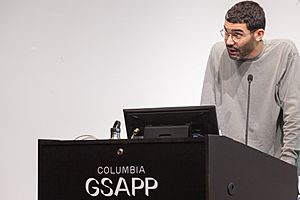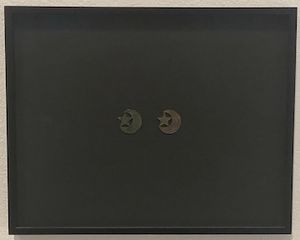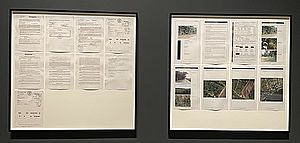Cameron Rowland facts for kids
Quick facts for kids
Cameron Rowland
|
|
|---|---|

Rowland speaking at Columbia University in 2020
|
|
| Born | 1988 (age 36–37) Philadelphia, Pennsylvania, U.S.
|
| Alma mater | Wesleyan University (BA) |
|
Notable work
|
New York State Unified Court System (2016) Depreciation (2018) |
| Style | Conceptual art |
| Awards | MacArthur Fellowship |
Cameron Rowland (born 1988) is an American conceptual artist. This means he creates art that focuses on ideas and messages more than just pretty pictures. His art has been shown all over the world. People praise his work for how it looks closely at big problems. These problems include the history of slavery in the U.S., many people being in jail, and making up for past wrongs.
Rowland finished college at Wesleyan University in 2011. In 2019, he won a special award called the MacArthur Fellowship. This happened after he had many art shows by himself and with other artists. His art has been seen at famous places like the Museum of Modern Art and the Whitney Museum of American Art.
Rowland is known for a unique way of sharing some of his art. Instead of selling it, he often loans it to art collectors and museums. This idea is meant to be like how some stores let people rent items to own them later. It helps show how money and value work in the modern art world.
Contents
About Cameron Rowland
His Life Story
Cameron Rowland was born in Philadelphia, Pennsylvania in 1988. He became well-known for his conceptual art. This art looks at unfairness in society. He often uses everyday objects that he gets through unusual ways.
His art became more popular after shows at the Essex Street gallery in 2014 and MoMA PS1 in 2015. In 2019, he gave a speech at his old college, Wesleyan University.
Rowland currently lives and works in Queens, New York.
How He Makes Art

Rowland's art often criticizes systems and groups that cause or benefit from unfair treatment based on race. He finds many of the objects for his art in online government auctions or scrap yards. He also gets them from old government buildings or companies that make security items.
These objects are often things people don't notice. But they are very important in daily life. For example, one of his artworks uses manhole leveler rings. These rings help adjust manhole covers when roads are paved. Few people would recognize them. However, they are a main product made by people working in New York State prisons. They are a key part of city streets.
Other artworks use things like wooden desks and benches. These were made by people in prison who were paid very little. Rowland wants museums to do more than just show art about unfairness. He wants them to actually help change how people live.
Rowland is an artist who can set rules for how his art is collected. Sometimes, collectors can only rent, not own, certain artworks. Rowland explained that this rental idea is like stores such as Rent-A-Center. At these stores, people often pay much more to rent an item than to buy it right away.
For Rowland, this lending model changes how art is valued. It makes people think about how artists and collectors exchange money. Since 2015, about half of Rowland's artworks have been available this way. His 2019 show at Art Basel in Miami Beach only featured works that were rented, not sold.
Important Art Shows
"91020000" (2016)
In 2016, Rowland had a show called 91020000 at Artists Space in New York. The title comes from Artists Space's customer number with Corcraft. This company makes cheap products for government groups, schools, and non-profits.
Rowland bought four courtroom benches, an office desk, and seven manhole rings. He did this with Artists Space's help. These items were placed in the art space. Viewers would not know their meaning until they read a paper that came with the art. The paper explained that people in New York State prisons made these objects for very low pay. Rowland believes this prison labor is a modern form of unfair labor, like neo-slavery.
In an essay, Rowland explained how the 13th Amendment made it possible to jail former slaves for minor reasons. This allowed companies and governments to use their free labor. He also explained how a similar idea was used during the War on Drugs in the 1970s. Since then, many more people, especially African Americans, have been put in jail.
Rowland sees himself as an artist who investigates, like a reporter. He looks for facts and evidence to support his ideas. He also buys these objects to challenge their unfair history. He takes these items that show a bad past. He makes them into art that highlights unfair systems.
One artwork in the show was Disgorgement (2016). This was a legal agreement. Rowland used some of the show's money to buy shares in an insurance company called Aetna. This company had insured enslaved people for slave owners long ago. Rowland plans to keep these shares until the U.S. government pays reparations for slavery. Then, the money from the shares will go towards those payments.
"D37" (2018-2019)
D37 was shown at the Museum of Contemporary Art, Los Angeles (MoCA) in 2018 and 2019. It was one of Rowland's biggest solo shows. Rowland used the art show's money and his research to show how Los Angeles forced poor people and people of color out of their homes.
Bunker Hill, where MoCA is located, was once a neighborhood for Mexican and Chinese residents. It was marked "D37" on a map, which gave the exhibition its name. In 1939, it was given the lowest safety rating by a group called the Home Owners' Loan Corporation (HOLC). This group called Bunker Hill a "slum area" and a "melting pot." HOLC later became the Federal Housing Administration. This group tried to hide its unfair actions by doing small community services. Rowland's D37 focuses on these examples of legal unfairness. He shows how the government made its own rules to justify its own wrongs.
The gallery showed carefully chosen objects that police had taken from people. These included used bikes, two leaf blowers, and a green stroller. Another artwork, Assessment (2018), was an old grandfather clock from a plantation in South Carolina. This clock stood at the end of the gallery. The show also included old tax papers from Mississippi and Virginia. These papers showed how these states made money from enslaved people. They relied on enslaved people to build their cities and governments.

The show ended with Depreciation (2018). This artwork includes legal papers and contracts. They show how Rowland used money from the D37 show. He used some money to buy one acre of land on Edisto Island, South Carolina. He did this to limit the land's use and make its value zero.
He did this because of a broken promise from 1865. That promise said that formerly enslaved people would receive forty acres and a mule, which included Edisto Island. But President Andrew Johnson took back this promise in 1866. In 2023, the Dia Art Foundation agreed to a long-term loan with Rowland. They will care for the land and show the exhibition papers. Unlike other land art, this land is not open to the public. This was Rowland's choice to prevent anyone from using the land.
Notable works in public collections
- Handpunch (2014-2015), Hessel Museum of Art, Center for Curatorial Studies, Bard College, Annandale-on-Hudson, New York; and Whitney Museum, New York
- Disgorgement (2016), Museum of Modern Art, New York
- Insurance (2016), Museum of Modern Art, New York
- Insurance (2016), Art Institute of Chicago
- National Ex-Slave Mutual Relief, Bounty and Pension Association Badges (2016), Museum of Modern Art, New York
- New York State Unified Court System (2016), Museum of Modern Art, New York (Work rented to museum, at cost)
- Payroll (2016), University of Chicago Booth School of Business Art Collection
- Jim Crow (2017), Carnegie Museum of Art, Pittsburgh
- 2015 MOCA REAL ESTATE ACQUISITION (2018), Museum of Contemporary Art, Los Angeles
- Assessment (2018), Tate, London
- Depreciation (2018), stewarded by Dia Art Foundation, Beacon, New York
- Group of 11 Used Bikes - Item: 0281-007089 (2018), Museum für Moderne Kunst, Frankfurt, Germany (Work rented to museum, at cost)
- Stihl Backpack Blower - Item: 0514-005983 (2018), Museum für Moderne Kunst, Frankfurt, Germany (Work rented to museum, at cost)
- probability of escape (2020), Institute of Contemporary Art, Miami
- Lynch Law in America (2021), Art Institute of Chicago
Awards
Rowland received a special award called a MacArthur Fellow in 2019.
Exhibitions
Rowland has had many solo art shows. These include Bait, Inc. (2014) in New York, 91020000 (2016) in New York, Birmingham (2017) in Cologne, D37 (2018) in Los Angeles, 3 & 4 Will. IV c.73 (2020) in London, and Amt 45 i (2023) in Frankfurt.
He has also been part of many group art shows. These include La Biennale de Montreal (2016), Whitney Biennial (2017), São Paulo Art Biennial (2018), and Afro-Atlantic Histories (2021-2023).

